IDEX Online Research: Polished Diamond Prices Stabilize in November
December 04, 12
(IDEX Online) – Positive consumer demand for jewelry in the early days of the 2012 holiday selling season have provided just the kind of good news that the diamond market needed. As a result, polished diamond prices stabilized in November, according to the IDEX Online Polished Diamond Price Index, widely acknowledged as the most accurate industry polished diamond price monitor.
And there’s even better news: in the first few days of December, polished diamond prices have risen sharply.
While preliminary sales trends in November were not at “blockbuster” levels, they showed enough of a gain – in the low-to-mid single digit range – to help keep diamond prices from falling further, as it appeared was happening in October.
This is all good news for the jewelry and diamond market, especially in the face of high levels of uncertainty among shoppers, especially in the U.S. market.
While the presidential election is over, other factors are keeping uncertainty levels high: the American “fiscal cliff” that is looming and threatens to push the U.S. economy back into a recession in 2013, saber-rattling in the Middle East that continues to wax and wane, meteoric growth of Asian economies that has cooled, and the global economy that continues to wobble, with daily dose of good – and bad – news.
The only good news is that the U.S. presidential election is over. Historically, consumer demand returns to normalized levels about six weeks after the election.
Polished Diamond Prices Stabilize in November
Polished diamond prices drifted slightly lower in early November, troughed mid-month, and began to edge upward in the final few days, a trend that continues. The graph below illustrates monthly diamond prices for the past two years:
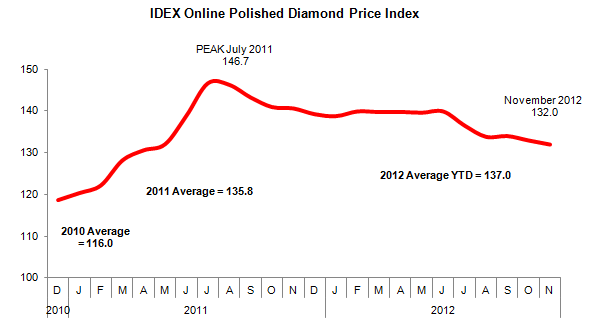 Source: IDEX Online Research |
The global polished diamond industry continues to seek some glimmer of good news that will push prices higher in the coming months. The global economy remains soft, but the U.S. economy recently showed stronger-than-expected growth in the third quarter, buoying markets worldwide.
The U.S. accounts for about 40 percent by value of global polished diamond sales. However, there has been no definitive improvement in demand from other mature markets such as Europe or from emerging markets such as China.
Polished Diamond Price Trends
The IDEX Online Polished Diamond Price Index averaged 132.0 in November. In October, it averaged 133.0 and in September the IDEX Index averaged 134.0. It stood at 140.7 a year ago.
Here’s what this means:
· November versus October prices: down 0.7 percent – Polished diamond prices in November were down 0.7 percent when compared to October. Month-to-month diamond prices have slipped seven of eleven months so far in 2012. However, with prices edging higher late in the month of November, there are some signs that prices in the polished diamond market may have stabilized and perhaps headed higher. The graph below illustrates monthly price changes for the global polished diamond market.
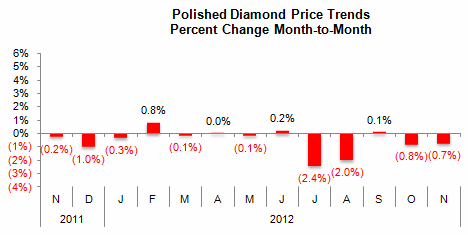 Source: IDEX Online Research |
· End of November prices versus beginning of month prices: up 0.5 percent – Polished diamond prices closed the month of November notably higher than at the beginning. Since the end of November, polished diamond prices have continued to rise.
· November 2012 versus November 2011 prices: down 6.2 percent – The rate of decline in diamond prices on a year-to-year comparison has stabilized, as the graph below illustrates.
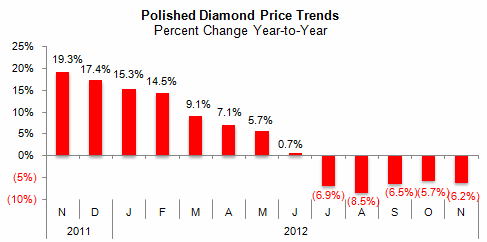 Source: IDEX Online Research |
· Daily prices of polished diamonds were generally stable, with a bottoming in mid-month, followed by some improvement near the end of the period. The graph below illustrates daily price movements for polished diamonds during November 2012.
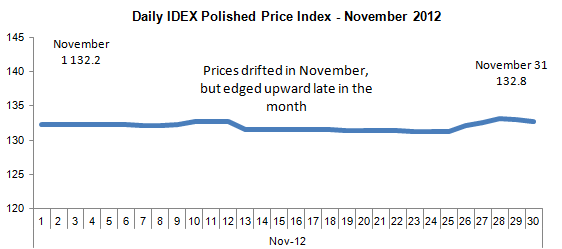 Source: IDEX Online Research |
· Year-to-date polished diamond prices: down 4.9 percent – For the first eleven months of 2012, polished diamond prices have fallen by 4.9 percent from their January levels. This decline has continued to increase throughout the year.
· First eleven months of 2012 average prices versus the same eleven-month period in 2011: up 1.1 percent – Due to very weak prices in early 2011, the mathematical comparison of 2012 versus 2011 looks favorable. The gap between 2012 average prices and 2011 average prices continues to close.
Diamond Prices by Size: Modest Decline
Prices by size for round cut diamonds declined for all major sizes in November, when compared to prices in October. The good news: the decline was much less than in prior months. The graph below summarizes month-to-month price changes for polished diamonds by size.
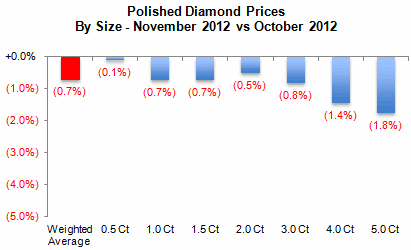 Source: IDEX Online Research |
On a year-over-year comparison, polished diamond prices in November 2012 were down for all key round-cut diamond sizes, compared to November 2011, as the graph below illustrates. While these price declines were fairly consistent across all sizes of diamonds, the drop in price was smaller than in most prior months.
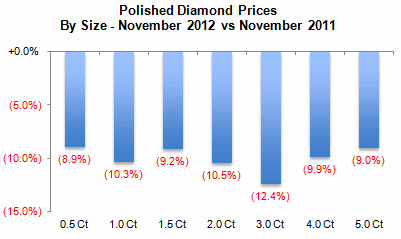 Source: IDEX Online Research |
Long Term Trend Shows Diamond Prices Weakening Since Mid-2011 Bubble
After rising slowly since mid-2010, most polished diamond prices – by carat size – were relatively stable during the first half of 2012, and then began to fall in the summer. Prices in September appeared to stabilize, but slipped further in October.
November polished diamond prices suggest that perhaps we have reached bottom in the current cycle, with the possibility of a lift in 2013. November polished diamond prices slipped for all major round stones, though they were up for almost all fancy cut stones. The graph below illustrates price trends by diamond size (all rounds).
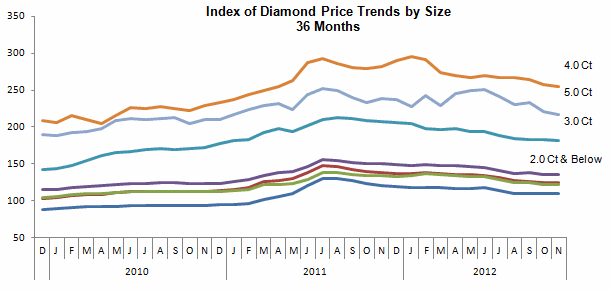 Source: IDEX Online Research |
Short Term Outlook Unchanged – Lackluster Price Trends
With the global economy barely limping along, consumers in most parts of the world have tightened their purse strings and reined in their discretionary spending. Overall, though, it appears that the current positive factors affecting diamond prices in 2012 may be beginning to overcome the negative factors.
· The OECD Composite Leading Economic Indicators for the Euro Area, continue to point to below-trend economic growth.
§ Europe has slipped into a mild recession, and consumers have cut spending. European diamond demand represents less than 10 percent of total global diamond and diamond jewelry sales.
§ U.S. economic growth remains lackluster, with very weak gains in the first half of 2012 but with a bounce-back in the third quarter. Jewelry demand – as measured by fine jewelry sales at specialty retailers and other merchants – slowed in the first half of 2012 to a mid-single digit level from a string of double-digit quarterly gains in 2011, a level which seems to be holding stable. Diamond demand in the U.S. market represents nearly 40 percent of the global diamond market.
§ China’s diamond demand remains relatively solid, but its blazing economic growth during 2010 and 2011 has slowed this year. As a result, we expect diamond jewelry demand to pause from its previously torrid pace until it is clear that strong economic growth is sustainable in the country. China represents just over 10 percent of global diamond demand.
§ India’s demand for diamonds seems to have weakened recently, though the long-term prospects are very bright. India’s diamond demand represents about 12 percent of global demand.
§ Japan’s diamond demand is showing some modest recovery, but since this market is only 8 percent of global demand, it is not having a notable impact on diamond prices.
Longer Term Outlook Brighter For Diamond Demand
Longer term, polished diamond prices appear to be headed higher due to several factors within the diamond market:
· Emerging markets, including China and India, are poised for solid long-term growth. As consumer wealth builds in these markets, shoppers will be spending more on jewelry.
· Rough diamond supplies – based on credible data – appear to be flat, at best, for the next decade or longer. With flattish supply, but rising demand, the forces of capitalism will push diamond prices higher.
Until global economic conditions solidify and accelerate, it is unlikely that polished diamond prices will begin to move substantially higher near term, though there are some signs that the current price cycle has bottomed.
The table below summarizes the average price of polished diamonds, using the IDEX Online Polished Diamond Price Index. The pre-recession peak for diamond prices occurred in August 2008 (box). As expected, polished diamond prices were weak during the “Great Recession” which officially ended in mid-2009. Unfortunately, polished diamond prices lagged the general economic recovery, and did not begin to show an upward bias until early 2010. The new, latest record price level (red box) occurred in July 2011.
 Source: IDEX Online Research |